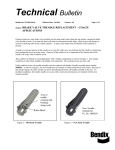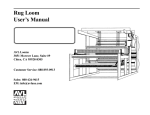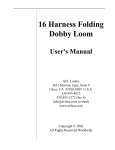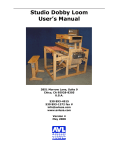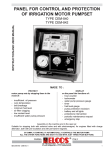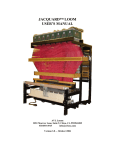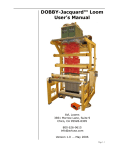Download cover - The Grand Domestic Revolution
Transcript
The Grand Domestic Revolution User’s Manual no. 2 Cottage Industry (Making Accommodations) Textiles have always been central to political-economic developments throughout the world, and textile production methods can be seen to represent the state of labor, industry, and exchange as a whole. If we are to experiment with the private sphere as revolutionary microcosm, I recommend adopting domestic modes of production and exchange that can manifest that revolution physically, in action! To this end, I initiate ‘cottage industry,’ and provide means for producing textiles here, in the apartment. Enclosed is the complete printed manual, covering use of the small, simple looms I’ve left here, as well as the much larger, more complex floor loom. When attempting to record the many steps of the many processes weaving entails I was continuously confronted with the failure of text and image to transmit the ‘tacit knowledge,’ embedded bodyknowledge which comes through direct experience and close observation. To fill these gaps, a technical solution: video tutorials on-line, and the opportunity for live video chat via the provided eMac or through your own skype account on your laptop. These techno- logical fixes are available on my homepage, actionweaver.com. Just press the ‘GDR weaving help’ button, or ask Yolande! In these ways- I make the technique and apparatus of hand weaving available to you, residents and visitors to the Grand Domestic Revolution. Experiment! Investigate production methodologies and labor dynamics. Develop finished wares from the material you produce, and negotiate how they will be used or exchanged. This ‘GDR Merchandise’ could be used in two exciting ways: enabling non-monetary exchanges and thus extending the ‘domestic relations’ to the local community; and if brought into a home and used, the revolutionary labor action embedded in the cloth may be celebrated in a private, domestic sphere. I hope the blanket I’ve left for you transmits this intent in some small way, if you sleep under it during your stay. If you make something using the cotton or wool yarn provided, you can sew on one of the provided ‘care instruction’ tags, and sign it as your contribution! Thank you, Travis Joseph Meinolf, Casco, 2010 The Grand Domestic Revolution -User’s Manual no. 2 Cottage Industry (Making Accommodations) Table of Contents Introduction Table of Contents Mini Laser Loom Floor Loom Cover here 1 3 ati s tr illu warp by confused? helpful video tips on actionweaver.com, my website I am quite proud of the mini laser loom, which I developed through study of weaving tools of the world, in pursuit of my Master’s Degree in Textiles. It combines the ‘backstrap’ method of maintaining tension in the warp threads (fig. 1) with the simplest tool for weaving, a flat piece known as a ‘rigid heddle’. Using this loom and the organic cotton provided you can weave a coarse cloth perfect for many household needs. Iri sB ens on The Grand Domestic Revolution -User’s Manual no. 2 Cottage Industry (Making Accommodations) 1. Rough Cloth on the Mini Laser Loom upset? s on fig. 1 exactly to your specifications. So, if this is its last, chaotic, ‘fling’ you should probably allow it, rather than trying to control it too much now. If you have extra strings peel them off, or measure out a few more if you are short some. *Measuring your warp* 1 3 2 *Rolling* Once you have threaded every slot and hole of the loom, even out the ends, spread them to about the same width as the loom, and loop fig. 3 clamp them between a beam piece with a hemp twine loop, and the second, brace piece of the beam (fig. 3). Make sure all of the threads are caught firmly in between the two pieces and squeeze them together with fig. 4 one hand while gently pulling the warp bundle from the other side of the loom. Now roll the beam a couple times so that the threads wrap around the pieces and hold them together firmly (fig. 4). This design configuration allows the materials to become a key structural element of the loom, as you will soon be. There is a peg board for measuring threads on one of the bookshelves in the GDR flat, perhaps you’ve noticed it. To get the 40 strands that will make up your warp, pull the end out of one of the balls of yarn and tie it to the top-left-corner peg. Leaving the yarn loose, but tight enough to stay on the pegs, make a ‘Z’ from left to right, across and down to the lower-left, and right to the far-right bottom peg. Remember not to pull too tight on the pegs, you are just starting out your relationship with this string, you will be asking a lot from it, so just stay loose. You also don’t want to break those pegs, they’re just dowels! When you bring the string around that lower-right peg you have one of your forty strands. Bringing it back along the same path to the top, you measure the second. Just do this forty times to make your complete warp, slide the *De-tangling* bundle off of the pegs and clip the ends to make 40 Take the loop in the center of the hemp string and strands. suspend the whole operation from one of the hooks installed in the flat’s walls. Once it is secure, pull the warp bundle taught and work the tangles out, moving fig. 2 the loom down as you go. *Threading the loom* If you come to a knot that won’t go through one of the holes just measure out a new strand and replace Now that you have your warp, it is time to thread it it. Most people get the best results by pulling the through the loom. Pull a piece of yarn from the bundle and whole bundle taught with one hand and slip it through the slot in the far right of the loom. Take gently guiding the loom down the another piece, maybe stiffen it with a little saliva and thrust length of the warp. This process it through the hole next to that first slot (fig. 2). Go across the can be frustrating but remember loom like this, taking each one of the forty threads and that if the yarns were not inclined filling all the slots and holes. Try to keep the ends even on to tangle, the fibers wouldn’t be the far side of the loom, and don’t worry too much if the able to form the solid, yet flexible main bundle seems to get a little tangled as you go. Rememfig. 5 structure of woven cloth. ber the strings and what you are about to ask of them, to allow you to arrange them in a very ordered state, (mostly) Cottage Industry (Making Accommodations): Mini Laser Loom Once you have worked the loom most of the way down the warp (not all the way off or you will have to start all over again!) get ready to roll the threads around the front beam. Pull the bundle so that all threads are evenly taut, and place the larger beam piece underneath them. Make sure you don’t have any loose threads fig. 6 hanging lower then the rest (slackers!) and place the brace piece on top of them, clamping them tight so that each strand is solidly secured, and then, in one movement roll this beam like you did the other (fig. 7), so that the yarns hold the beam together and you can strap it to your body. Simply pass the cotton strap behind your back and fig. 7 hook it onto the beam, not too tight, but close (fig. 8) Adjust the strap to a comfortable part of your back, and pull against the warp, not too hard, but so that the loom piece floats on the threads in front of you without having to hold it. *Weaving* The loom is built, and you are almost ready to weave! You can set it down on the floor, or on a stool and get some “weft,” the material that you will weave into the “warp” you have stretched before you. For these towels you can use the same bio-cottons provided for warp. Wind some 3 2 1 onto one of the shuttles, crossing the yarn over itself each time so it keeps nice and tidy (fig. 10). This fig. 10 also helps it to stay in order as you wind it off of the shuttle, into the body of the cloth. *The Loom* Now that you are strapped in, you have become a main compofig. 8 nent of the loom! It is your body pulling the warp taut that allows the ‘tool’ to function correctly. The warp threads also have structural functions, as laid out above, so that this ‘loom’ is an inter-dependent organic machine, user, material, and tool having equal importance. So how does it work? *Weaving* shed Keeping the warp tight with your body, pull up on the loom. Notice that the threads you put in fig. 9 the the loom’s holes (called heddles) are now yours to command, and as you lift the loom, they will raise above the threads that are through the slots, making a space known as the shed. You’ll pass the shuttle through this space, back and forth many times to make cloth, as will be explained in detail below. The rest becomes very predictable and repetitive, which for many can be quite therapeutic. Push the loom down, creating the second shed, and allowing you shed to pass the shuttle over all fig. 13 of the ‘blue’ threads and under the ‘yellow’ ones (fig. 13,14). As you lay in each weft piece, beat it into place with the loom. Remember that ‘beat’ is a weaving term, but it doesn’t mean you have to use a lot of force, you are really just placing the thread gently next to the last. You don’t want to put *The Shed* When you pull the loom up, lifting the ‘blue’ threads (fig.11), you create a shed. When you pass the shuttle through this space, you bring the shed weft over all of the ‘yellow’ threads and below all of the ‘blue’ ones. fig. 11 Pull the shuttle through (fig. 12) and leave the tail end of the weft, hanging from the shuttle, in the shed. As you pass the shuttle through the shed you can lower the loom, and pull it towards you to ‘beat’ the weft yarn into place. fig. 12 too much strain on the warp, or the loom. Also try not to pull too tight on the weft, fig. 14 you can even leave a small loop hanging out of the edge until you achieve the right balance; remember, a little loose is better than too tight. *Cloth* You are making cloth! When you can’t reach the loom and shed easily, just unhook the backstrap and roll what you have made onto the front beam, then hook back up and continue to weave. Of course you can also set it down and take a break. You did a lot! When you reach the end of the warp you can decide how you want to use your brand new cloth. Thank you, and peace. Travis J. Meinolf, Action Weaver The Grand Domestic Revolution -User’s Manual no. 2 Cottage Industry (Making Accommodations) 2. Fine Cloth on the Collapsible Counter-balance Loom H A) PEDALS (WITH CLIPS TO LAMS) B) BEATER (WITH REED) C) FRONT OR CLOTH BEAM (WITH GEAR) D) BRACE BAR (UNLOCK TO COLLAPSE LOOM) E) BACK BEAM F) LAMS G) HARNESSES B H) BALANCE BARS (nails to lock gear) D C G B F E A A Once you have the hang of weaving on the mini-loom, you might feel ready for the new challenges, and rewards, of weaving on a larger and slightly more complicated scale. The basic premise, of separating warp threads in sections, and passing weft threads through sheds, remains, with just bit mechanical intervention. The machine in question is the collapsible floor loom you may have noticed leaning somewhere in the GDR flat. The first step towards its use is to get it out and set it up. *THE LOOM* The loom should remain threaded for the duration of the project, saving you nephytes from the most tedious part of the process, sending the 600 threads through the beater and the 600 heddles, ‘programming’ the pattern for the cloth. *SET-UP AND STORAGE* warp threads pivot point locking wing nut 2 A 3 1 To assemble the loom simply place it flat on the ground, make sure all of the gears are unlocked (remove nails at C and E, as seen below), swing the frame upright and lock the brace bar using the provided wing nut. Go slow, and if you encounter resistance, watch where the wooden pieces slide against one another. Next you will need to use the clips dangling from the treadles to attach them to the loops that hang from the lams directly above them. When you are finished weaving merely unclip the treadles, undo the brace bar at the wingnut and reverse the process. Bind at the center and lean it against the wall, 3 2 nicely out of the way. 1 B The loom is basically a frame for pulling the warp threads tight, just like you had to pull on the mini-loom to weave. It should be left with a little weaving sticking out of the reed (A), or warp threads in bundles (B), and you should secure them to the dowel attached to the front beam by locking the back beam and tieing htose threads on tight. Then lock the front beam so that the warp is held in tension, with the knots pulled towards the front bar giving plenty of space to test your shed. *OPENING THE SHED* Sit at the loom and step on pedals. They are color-coded for ease of use and demonstration. See how they control the warp threads by * pulling the harnesses (G) apart and making a shed * to pass the weft through, as you must already be familiar with from using the mini laser loom so much! Cottage Industry (Making Accommodations): Floor Loom *BEGINNING TO WEAVE* First you will need to make a long bundle of 10 or so yarns, step on one of the white pedals, and send it through the shed. Step on the other pedal and use the beater to pull the bundle into place. Send the thick bundle through again to make a foundation for your thinner threads. *ADVANCING* As long as there is warp rolled around the back beam you can keep advancing and weaving by unlocking the two beams, unrolling a foot or more of warp from the back, re-locking the back beam and pulling the warp tight. Then lock down the front beam and sit back down to weave. When there is no more warp to advance, your piece is done! Cut it off of the loom, leaving some, to hold the pattern (as it Find the yarn that seems appropriate for the warp on the was when you found it), and loom and wind some onto a bobbin using the bobbin winder make something special for the house or for yourself or provided. Use the clamp whatever! As the producer you should definitely to secure it to a table stick a decide the outcome you are most comfortable with. bobbin onto it, and turn the I traded some cloth I made there to the screenhandle to wind on yarn! Then printing shop next door and they made us these nice pop the bobbin into your ‘care intstruction’ tag that you can sew on, so nobody will shuttle and pull the tail end out shrink you precious wools, and you will be marking it as a of the slot in the side. bobbin winder, bobbins, shuttle product of this household, of your hands. Sign it, too. Sit back at the loom and step *THE NEXT PIECE* on one of the white pedals again. Pass the shuttle through To start another weaving you will get to really make it the shed, leaving a trail of thread! Step on the other white from ‘scratch’. Remember measuring out your 40 threads pedal, beat the weft with the reed, and repeat. As with the for the mini-loom? This will be the same, at the warping mini-loom leave a bubble of weft at the edge and watch it board on the bookshelf, except instead of using the four get pulled into the cloth. Don’t pull it too tight or you can corner pegs, you will use all of them. Zig-zagging between, hurt the threads and the loom. Weave a few inches this way, up and down like you did before, but much longer. You can practicing stepping on the pedals, opening up the shed, and just measure out bundles of 60 though. Ten times, please! passing the shuttle through. You are making plain weave! You can use different colors to make nice vertical stripes in If you feel any resistance while you step on the pedal your piece. And once you have our 600 threads, instead of check that nothing’s tangled up between the harnesses and threading the whole loom you just have to tie each the pedals. It should be a straight line between each thread to the warp that is on the loom, coming from the harness to the lam and its pedal below. reed. Once they are all tied nice just pull on the old *PATTERNS* * warp, from the back, to get the new one through To weave a pattern into cloth, you alter the structure reed and the heddles. It’s easier to do this in sections, that you are forming with the threads. This is working across the loom. done by stepping on different pedals as you *BEAMING* weave. Notice if you step on the red pedal the With your new warp through the reed and harnesses two front harnesses drop, and the rear ones (known as the castle by some) now you must roll it onto the rise. Then the yellow pedal drops the two center harnesses. back beam to make it available to weave. Roll the back If you send a shot of weft through the shed beam clock-wise until you meet resistance, probably a now you will see that rather than passing tangle in the reed, and slide the nail into the gear-lock. Come over single threads, the weft is now going to the front of the loom and detangle the warp by pulling over pairs of warps, and as you pedal against it and running your fingers through it. Then return across the rainbow it shifts over by to the back beam and roll again. Repeat as necessary, until one each time, producing twill. there is just enough yarn to tie onto the front rod and start a You can make a nice, regular fresh weaving! Always use a thick bundle of yarns as weft to pattern by just repeating these four pedals, red-yellowstart, then wind some bobbins and get to work! green-blue-red-yellow...&c, or you can make a kind of *FINAL NOTE* zig-zag by changing directions, and you can definitely try I want to be available to all who stay at the GDR, to out compositions of your own, and incorporate the white provide more guidance and to hear your experiences. Until I pedals again, too! A nice piece of cloth might be mostly can visit Utrecht again, I’ve at least made some informative plain weave, with bands of twill throughout, or vice-versa. supplementary materials available on-line at my homepage, You can also experiment with materials, there is a nice yarn actionweaver.com, or call me! Thanks, and again, peace. shop down near Lijn Straat, I think. Travis Joseph Meinolf When your shed starts getting very small, and your Casco 2010 weaving is beginning to look big, it’s time to advance your warp, by pulling out the nails that lock the beams.







